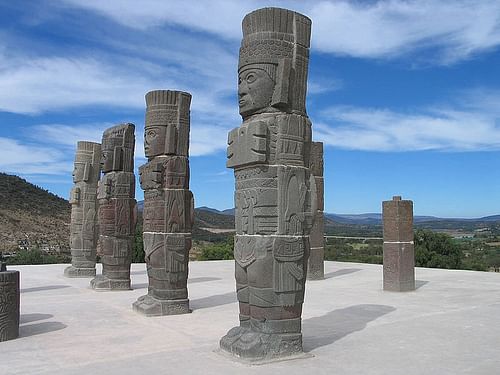
Mixcoatl, 'Cloud Serpent,' was a Mesoamerican god identified with hunting, the Milky Way and the stars and heavens in general. The god may originally have derived from a deified hunter and warrior-leader of the Toltec-Chichimec peoples of central Mexico. In mythology, he is the father of the southern constellations and the great Mesoamerican god Quetzalcoatl.
Name & Associations
The name Mixcoatl may be literally translated as 'Cloud Serpent' which is how the ancient Mesoamericans imagined the Milky Way in the night sky. Mixcoatl was the son of the primordial creator gods Tonacatecuhtli and Tonacacihuatl in some traditions; in others, he was the son of the earth goddess Itzpapalotl ('Obsidian Butterfly') while his wife was Coatlicue ('Serpent Skirt'), another earth-fertility goddess. Mixcoatl was considered the father of the Centzon Huitznahua, the 400 sons representing the southern stars. Also, by changing himself into a deer and forcing his attentions on either the great huntress Chimalman or the earth goddess Cihuacoatl, he was parent to Quetzalcoatl, the great feathered serpent god of Mesoamerica.
Mixcoatl was the patron or main god of the Chichimecs (and many other peoples who claimed descent from them) and the Otomi of central Mexico. As Camaxtl he was especially worshipped at Huejotzingo and Tlaxcala. The later Aztecs largely replaced Mixcoatl with their own powerful sun and war god Huitzilopochtli, although he was associated with Red Tezcatlipoca, an aspect of the all-seeing and omnipresent supreme god of the Aztec pantheon Tezcatlipoca. In one tradition Tezcatlipoca transformed himself into Mixcoatl and then invented the fire-drill for the benefit of humanity. Finally, Mixcoatl was associated with lightning, thunder, and the direction North.
Festivals & Worship
Mixcoatl the god was associated with the 14th Aztec month, Quecholli (a type of bird), when feasts and hunts were held in his honour on Mt. Zacatepetl. The hunters dressed themselves as the god, made arrows, and set ritual fires to commemorate this gift. It was during this festival that women took their young children to dance with Mixcoatl's priestesses, who were given cakes. Bloody human sacrifices were made to the god, too, described here by the historian M. E. Miller:
A man and a woman were sacrificed to Mixcoatl in his temple. The female victim was slain like a wild animal; her head was struck against a rock until she was half-conscious; then her throat was slit and the head decapitated. The male victim displayed the head to the assembled crowds before he himself was sacrificed by heart extrusion. (116)
Mixcoatl, along with various other hunting gods and Tezcatlipoca, was also honoured during the 5th month of Toxcatl ('Drought') with a festival which included another round of actual animal hunts and a staged hunt of prisoners of war dressed as deer. Feasts and the sacrifice of honoured god-impersonators rounded off the festivities.
The Toltec Mixcoatl
Something like Hercules in Greek mythology, Mixcoatl was perhaps originally an ordinary mortal who gained fame, and as a great hunter, warrior, and leader, consequently earned his deification. The Toltec Civilization flourished between the 10th and mid-12th century CE in central Mexico, and according to tradition, their legendary chieftain Ce Tecpatl Mixcoatl ('One Flint Cloud Serpent') led them from the deserts of the north-west to Culhuacan in the Valley of Mexico. Mixcoatl, by impregnating with an arrow his wife, a local Nahua woman named Chimalman, had a son, Ce Acatl Topiltzin who was born on the day 1 Reed, either 935 or 947 CE. Topiltzin took on the honorary title Quetzalcoatl and won great renown as he consolidated and expanded the Toltec-Chichimeca empire with its impressive capital at Tollan.
Representation in Art
The god is represented on the gilded handle of an Aztec hardwood dart thrower (atl-atl) now in the British Museum, London. Here he wears a fanged mask, ear-spools in the form of deer hooves, and an eagle-feather headdress while battling a rattlesnake. Mixcoatl appears in codices wearing red and white striped body paint, a black mask on the upper part of his face, and eagle feathers. As with other star-associated gods, he may have stars on his face. He is typically carrying a bow, bunch of arrows, and a hunting net or basket and is sometimes in the act of slaying a jaguar, reminding of his role as patron of hunters.






